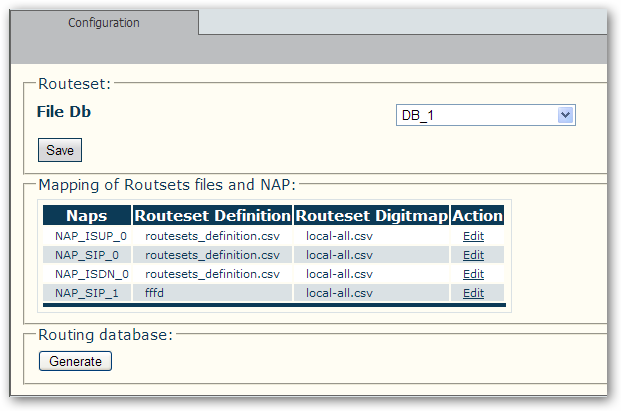Label Routing
Routeset Routing is an algorithm that combines Digit Analyzer and the concept of RouteSet. It is implemented as a RoutingScript in Toolpack Gateway. This algorithm allows complex routing rules, as normally available with RoutingScript, but on a very large number of destination numbers.
Contents |
Concept
The concept behind routeset routing is quite simple.
- A list of numbers (NPA-NXX) for a specific destination is assigned a RouteSet name. This list can be very large
- i.e., 514201,514202,514203, ... -> "Montreal, Qc"
- The list of routes for the destination is assigned the same RouteSet name. This list usually is limited to the number of network access points (NAP) in the system.
- i.e., Bell, Rogers, Videotron -> "Montreal, Qc"
Note: No matter how many destination numbers lead to a given destination, only a limited list of routes are selected. At this point, complex, yet efficient, routing rules can take place.
Implementation
As previously mentioned, Routeset Routing is implemented as a RoutingScript. It was written as an optional filter, and can be used in any existing scripts. This filter is a before_filter, and reduces the amount of routes the routing script will work with.
Provisioning
Provisioning of large amounts of Routeset Definition and Routeset Digitmap is accomplished by importing CSV files using the WebPortal. Those files are being saved in the HA Database.
Routeset Definition
Each NAP in the system must be assigned a routesets_definition CSV file. A routesets_definition file gives the association between NAP and RouteSet names. The association between a NAP and a RouteSet name is in fact a route! ie: Rogers->"Montreal, Qc" Thus, for each RouteSet name<->NAP association, a dynamic route entry gets created.
The Routeset Definition file defines a list of RouteSet names, with optional attributes.
- One mandatory column: routeset_name
- Supplementary columns are used to provide optional and custom attributes to dynamically created routes
routeset_name, cost, custom_1 "Montreal, Qc", "0.24", "custom_val"
In the above example, routes are created with custom attributes found in the second and third columns. Each custom attribute must be defined by adding a custom column in the gateway Route table.
The NAP <-> Routeset Definition association is done by setting the NAP dynamic columns named 'routesets_definition'. More than one NAP can point to the same 'routesets_definition' file. This file must be imported in the database using the File Db view in the Toolpack Web Portal.
Add the routeset definition NAP dynamic column
- Click the Gateway->Configurations->Naps menu
- Click the 'Create New Nap Column' link
- Complete the form as follows:
- Name = routesets_definition
- Type attributes = dbfile
- Default =
- Name = routesets_definition
- Click 'Create' to save
Routeset Digitmap
Each NAP in the system can be assigned a routesets_digitmap CSV file. It is usual that all NAP uses the same routesets_digitmap file. A routesets_digitmap file gives the association between numbers and RouteSet names.
- Three mandatory columns: route_set_name, called and calling
called,calling,routeset_name 403200, ,"Calgary, AB" 514201, ,"Montreal, Qc" 514202, ,"Montreal, Qc" 514203, ,"Montreal, Qc"
The NAP <-> Routeset Digitmap association is done by setting the NAP dynamic columns named 'routesets_digitmap'. This file must be imported in the database using the File Db view in the Toolpack Web Portal.
Add the routesets digitmap NAP dynamic column
- Click the Gateway->Configurations->Naps menu
- Click the 'Create New Nap Column' link
- Fill the form as follow:
- Name = routesets_digitmap
- Type attributes = dbfile
- Default =
- Click create to save
Dynamic Routes
When provisioning is complete, dynamic routes can be generated by going in the Routetsets menu item, under Gateway menu Item.
How to setup Label Routing to create dynamic routes
Setting up label routing is simple, since it is using pre-defined scripts, all available from the web portal. It is done in 6 steps:
- Create default routing scripts and activate routeset script
- Create a new file repository (FileDb) for storing the Digitmap and Routeset definition files
- Enable Label Routing script and File Db in Gateway configuration
- Create Digitmap file and add it to the system
- Create Routeset definition file and add it to the system
- Associate NAPs with the Digitmap and Routeset definition files
- Generate Dynamic Routing table
- Activate Configuration
1. Create default routing scripts and activate routeset script
From the Web portal go to
Gateway -> Routing Script -> Create New Script
- Name: Label_Routing
- Select "Create default script files"
- Create
To activate the routeset script:
- Click on "Examples Scripts"
- Edit "routesets_routing.rb"
- Select "Load on Startup"
- Save
You must also deactivate the simple_routing script:
- Click on "Examples Scripts"
- Edit "simple_routing.rb"
- Unselect "Load on Startup"
- Save
It is also possible to add the Label routing to any Routing Scripts this way:
Adding Label Routing to any Script
Using routeset routing
RouteSet routing can be implemented by following these 3 simple steps:
- Add a the following line on top of your script file:
require 'routesets_digit_analyzer'
- Include the module in your routing class:
class MyRoutingClass < BaseRouting
- include RoutesetsDigitAnalyzer
- ...
- end
- Add a before_filter with 'routesets_digit_analyzer' method:
before_filter :method => :routesets_digit_analyzer, :trie_order => :called
Complete Example
require 'base_routing'
require 'routesets_digit_analyzer'
class MyRoutingClass < BaseRouting
include RoutesetsDigitAnalyzer
before_filter :method => :routesets_digit_analyzer, :trie_order => :called
route_match :call_field_name => :called
route_match :call_field_name => :calling
route_match :call_field_name => :nap
route_match :method => :match_nap_availability
route_remap :call_field_name => :called, :route_field_name => :remapped_called
route_remap :call_field_name => :calling, :route_field_name => :remapped_calling
route_remap :call_field_name => :nap, :route_field_name => :remapped_nap
end

